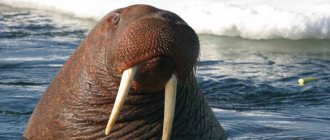Killer whales are marine animals that live in almost all seas and oceans. Sometimes they enter inland seas, but their main place of residence is marginal oceanic seas and open ocean spaces. These huge sea predators do not need land and they approach the shore only because marine animals live there, which often serve as prey for them.
Being very smart, killer whales are able to hunt both alone and in a school. Solitary killer whales are quite rare; most often they live in groups. Moreover, these groups come in two types: resident and transit.
Description and features
When this underwater giant swims close to the surface of the water, and its fin on its back rises almost two meters above sea level, it becomes clear that it is a male swimming. Males are larger than females, and reach 9-10 m in length and weigh 7.5-8 tons. The female's fin is almost half as long and curved. The average length of a female is 7-8 m, weight is about 4.5 tons.
The mammal's head is small, with a flat forehead, without a dolphin "beak". The eyes are also small. The teeth are massive and sharp, up to 13 cm long, with which it easily tears apart large prey. The chest flippers are 60 cm long and 15 cm wide, not pointed, but wide, closer to oval in shape.
The color is very impressive, one might say “a pair of tails”. The satiny skin on the back and sides is mostly jet black, while the belly is dazzling white. Some killer whales living in Antarctica have slightly lighter sides than their backs. Behind the fin on the back there is a gray spot, shaped like a saddle.
There are white spots of different configurations and sizes everywhere on the sides, and there are such spots under the eyes. The shape of all the spots on a killer whale’s body is individual; by it you can identify the animal, like a person by fingerprints.
By the way, the snow-white areas on the body of a mammal in some regions may be slightly greener or yellower due to coloring algae. Sometimes there are completely black individuals - melanists, or completely white - albinos.
The killer whale in the photo makes a particularly indelible impression . It is not without reason that we mentioned the whale here again, because in some photographs it is very clearly visible how an unusually beautiful, graceful and large sea animal “throws” a small fountain of water upward. Just like whales do.
Social organization
Killer whales have a complex social organization. Its basis is the maternal group (family), usually consisting of a female with cubs of different ages and adult sons. Several families, led by female relatives (daughters, sisters or cousins), form a group or pack. One group contains an average of 18 individuals, and its members are strongly attached to each other.
Each group has its own vocal dialect, which includes both sounds made only by animals of this group, and those common to all killer whales. A very stable group, however, can break up into several parts, especially while searching for food. Several groups of killer whales may unite for joint hunting or various social interactions. Since all members of one group are related to each other, mating among killer whales presumably occurs when several groups unite.
Relations between killer whales within the pod are extremely friendly and non-aggressive. In the most extreme case, an indignant individual may slap its tail or pectoral fins on the surface of the water. Healthy killer whales take care of old, sick or injured relatives.
Kinds
Two more specimens can be classified as killer whales:
- Black killer whale , or small killer whale, is also called false killer whale because of its completely black color. It is inferior in size to the ordinary one, as it grows up to 6 m in length and weighs about a ton and a half. She is much more thermophilic than her relative, and has chosen temperate and subtropical waters for her habitat.
- Feresa is a small pygmy killer whale. She has grown only to 2 meters, feeds on small fish and tries not to catch the eye of humans. Painted dark grey.
About 6-7 years ago, an interesting character appeared on the Internet - a white killer whale named Iceberg. It was filmed twice near the Commander Islands. The video was accompanied by a comment that from 2008 to 2015, five such killer whales were spotted in the Russian part of the Pacific Ocean. However, it has been established that this is not a new species of animal, but an albino. Most likely, the white color has become an alarming indicator of an unsuitable environment.
Meaning
The saltwater dolphin is found in almost all oceans and seas. In Russia, it lives near the Kuril ridges and the Commander Islands. This animal is the top of the food chain, which gives them an advantage in obtaining food, although individuals of this species are in the Red Book.
These predators feed on almost any animal they come across. Despite this, people and killer whales are quite friendly with each other. Whales are highly trainable due to their love of dancing, but there have been several recorded cases of attacks on humans.
Lifestyle and habitat
The killer whale is found in the vastness of the World Ocean, from the tropics to the polar regions. It plies the endless seas from Antarctica to Canada and Kamchatka, and from Norway to the extreme point of South America. These beautiful and dangerous dolphins especially fell in love with the northern Pacific waters, the south of the Bering Sea, as well as the territory off the coast of the Aleutian Islands and Alaska.
Of the seas, they also preferred the Barents and White. You rarely see them in the Mediterranean. And they are not found at all in the Laptev Sea, as well as the Black, Azov and East Siberian Seas. In Russia, the killer whale lives near the Commander Islands and near the Kuril Ridge. It prefers places where the sea is cooler, so it does not stay long in the tropics.
After a long study, ichthyologists conditionally divided these rulers of the sea into two groups: “residents,” that is, permanent inhabitants of a particular region; and “temporary” or “transit”, those that ply across the ocean. There are also free-swimming predators, but they have been little studied, it is not clear where they swim or what they eat, so we won’t talk about them.
“Residents” form entire clans; they create married couples that do not break up for decades. They live in rather limited areas. The social structure is based on matriarchy. A female with cubs of both sexes forms one group.
The group consists of about 15 individuals. Killer whales are very smart, they have their own social laws, each group has its own dialect. These killer whales are considered the most peaceful, so to speak. “Transit” killer whales are less studied; in percentage terms, they are much smaller than permanent ones.
They are very cautious, move almost silently, they have been given the name “silent hunters”, they are impossible to detect and difficult to track. They hear at the same frequency as whales and make similar sounds, so they do not communicate while hunting so as not to scare away their prey. If they see a “resident”, they give way so as not to enter into conflict.
DNA tests have shown that these groups have not mixed for many thousands of years. Therefore, they gradually began to differ from each other, although not very much. For example, their dorsal fins have different shapes. These groups also have different taste preferences, and they also speak different “languages,” that is, they give different sound signals.
Killer whale or "killer whale"?
Many argue on this topic, since killer whales are called harmless birds from the family of swallows, and killer whales are huge sea inhabitants that can hunt all representatives of the seas and oceans that live in the aquatic environment, next to these bloodthirsty predators. How correct this is is truly debatable.
Killer whale is a barn swallow; moreover, this word was actively used in folk poetry to address female representatives. In addition, even men were called “killer whales”. If we turn to the etymological dictionary, the word “killer whale” comes from the word “killer whale” or “scythe”. In this case, this word has nothing in common with the well-known word “scythe”, which mows down. This refers to a woman's “braid”, which is comparable to the forked tail of a swallow.
Therefore, for many it is simply not clear how it happened that the predatory monster that lives in the vastness of the World Ocean was named killer whale. According to some, this name is associated with the peculiar shape of the dorsal fin, reminiscent of a braid. In fact, everything is much simpler, at least that’s what most people think, and the name is associated with the similar body color of the killer whale and the barn swallow, since their main color is black, with white spots, especially in the neck and belly.
If someone wants to separate these two names, that is their right, although in fact the words “killer whale” and “killer whale” are practically equal and there can be no mistake in either case.
Nutrition
Of course, many people are interested in what killer whales eat ? These animals have different nutritional spectrums. Each population has fairly narrow preferences. In the Norwegian seas they enjoy catching the famous herring, and every autumn they migrate closer to the coast after it.
Near them, other hunters specialize in pinnipeds. If we have agreed, for convenience, to divide killer whales into two species - “resident and transit”, we should also divide them according to food preferences. The former are piscivores, the latter are carnivores.
“Residents” specialize in shellfish and fish, preferring a less aggressive type of hunting. They line up in a chain and comb the sea in search of schools of fish, while constantly communicating with each other using echolocation. Having discovered a school, they surround it with the whole group and “knock it down” into a ball, and then “dive” into it, getting their prey.
But “transit killer whales” are precisely those brutal, fast predators. Their hunt is like an unexpected “forced march” designed to grab the most delicious and nutritious food. Most often, their victims are gray seals and northern eared seals, known to us as sea lions, or Steller's northern sea lions (named after the doctor Georg Steller, who went on expeditions under Bering's command and was the first to describe these animals).
Killer whales go out hunting for common seals in groups of three or four, drive the prey and kill it with their powerful tails. Five or six of them gather to hunt Steller's lions. They can pursue prey for up to 2-3 hours, but still achieve the desired result - after powerful blows with their tails, they drown the victim.
A whole “gang” is already gathering for giant whales. The killers surround the colossus and begin to wear him down, driving him to insensibility. The following case was described: off the coast of California, thirty killer whales surrounded a 20-meter blue whale and massacred it.
Someone hit him on the head with their tail, others tried to hit him on the sides, some jumped on his back or dived from below. A clearly organized robbery attack. Finally, they began to tear his meat. It was dangerous and pointless to interfere in this process. It is impossible to stop killer whales while hunting.
Steller sea lions, as Canadian ichthyologists have found, have greatly decreased in number over the past decades. If in the 80s of the last century there were several hundred thousand of them, now there are barely about thirty thousand. Nothing strange, only recently people declared a moratorium on their hunting. But killer whales don’t know this.
The meat of these animals is very juicy and tender, there is a lot of it, each specimen weighs up to a ton. Voracious predators appreciated the taste of sea lions and significantly reduced their population. However, in addition to seals and sea lions, other commercial targets for killer whales can be mentioned.
In the stomachs of the captured predators, the remains of sea turtles, penguins, polar bears and even strange victims for an aquatic hunter were found - moose! However, despite such omnivorousness, hunters sometimes show themselves to be gourmets and really like to feast on sea otters, or in other words, sea otters.
We also know these animals as sea and Kamchatka beavers. They are covered with thick hair, but this does not spoil the appetite of killer whales. The weight of the sea otter is 16-40 kg, very convenient and compact to swallow whole. In order to be satisfied, she needs to eat about 7 animals daily.
One killer whale per year is capable of swallowing about 2,000 of these marine animals if it hunts them daily. As a result, the number of sea otters has also fallen markedly over three decades, even though hunting for them by people is limited.
Lifestyle
These animals mate in winter, as this is the most favorable time of the year. The killer whale is a mammal, so it carries a whale in the uterus for 16-17 months.
The female is capable of producing offspring for 25 years. During this time, she manages to give birth to up to 7 cubs. However, females as old as 90 years . A predatory animal can catch a victim with its own jaws, jumping to the surface, or turn over an ice floe on which a seal is hiding. Sometimes sea dolphins hunt together with a school.
Reproduction and lifespan
Family ties within the same group do not allow these giants to mate within the pack. Therefore, individuals from different clans marry. Puberty occurs at 12-14 years of age. The breeding season begins in the summer and is always accompanied by a beautiful dance.
The “gallant gentleman” literally “surrounds” his girlfriend with attention, swimming around her. He touches her with all parts of his body - fins, nose, tail, making these movements inexpressibly tender and touching. It happens that a boyfriend gives souvenirs to his chosen one - various items from the sea, corals or shells.
Moreover, the female can keep these gifts for quite a long time. Finally, everything is in the past - hours of courtship, and even jealous fights with other males, the process of belly-to-belly mating has taken place, and now the expectant mother begins the long process of gestation. It lasts 16-18 months.
At this time, the whole flock takes care of and protects her. The “baby” is born already of decent size, about 2.5 -2.7 m. After the child “fell” into the water, the “retinue” leaves the mother and calf alone, giving them the opportunity to communicate in private. At first, the little dolphin hangs helplessly in the water, but then its parent comes to the rescue.
She pushes him to the surface of the water with her nose so that he can take a breath of air and get his lungs working. The female gives birth approximately once every 5 years. During her life, she can give birth to 6-7 “killer whales”. Around 40-50 years of age, a “lady” experiences a sexual lull, she is no longer able to give birth, and moves into the category of “matron”.
Killer whales and pilot whales (black dolphins) are the only species of animals that, like humans, meet old age among their relatives. And in an atmosphere of great respect. They go through menopause and continue to live and hunt for decades.
“Men” live up to 50 years, and “old ladies” live up to 75-80, even up to 100 years. In captivity, these periods are reduced by half or three times. Never, under any circumstances, do “residents” mate with “transit” individuals. This is another indicator for dividing them into separate groups.
How does an attack on dolphins happen?
The journal Aquatic Mammals published an article describing the dramatic consequences of such a hunt. The killer whales deliberately pursued their prey, moving closer and closer to the “catcher”, who was waiting for the dolphin in ambush. Once trapped, the dolphin was then attacked by the "catcher", who attacked the prey from below at a depth of approximately 5 meters. The authors of the article then say that a dolphin wounded in the stomach is divided between the “catcher” and his calf.
Researchers repeatedly observed the cub attempting to throw its food into the air. This suggests that this is how the young killer whale tries to adopt the behavior of its mother. So, it is quite possible that killer whales use this method of hunting specifically to teach their offspring.
The researchers were able to observe a similar incident a year later. The same method of ambush hunting was used by other killer whales living in this region. They attacked the dolphin at a depth of about 2 meters, as a result of which the victim lost the creature. The meat was then divided among all members of the flock. Scientists suggest that this sharing of food may play an important role in maintaining social unity between members of the same flock.
Why is the killer whale called the killer whale?
To understand why the killer whale is a killer whale , you need to delve a little into history. In the 18th century, the Spaniards called this huge dolphin “killer of whales” - “asesina ballenas”, and the British incorrectly translated it from Spanish into their language, and it turned out “killer whale” - “killer whale”. This is how we got the third myth. In fact, their temperament varies, just like ours. They have their “homebodies” and “vagrants”.
“Homebodies” is a quality inherent in “resident” killer whales. They do not like to feed on warm-blooded creatures and do not show aggression towards humans or other mammals.
“Vagabonds” is a trait similar to “transit” killer whales. Most likely, they gained an ominous reputation as murderers. Not even because they are ready to kill any creature in the sea. First of all, they are called that because, like real robbers, they kill more victims than they can eat. If they kill a whale and are not able to eat the whole carcass at once, they eat only some parts of the body, those that are tastier and softer (tongue, lips, etc.).
In the depths of the ocean, killer whales have no worthy opponents. Even the formidable and ferocious white shark is not its competitor, but its prey. It sounds absurd, but it’s true: the terrible white predator’s only enemy is the killer whale dolphin.
Every year, scientists find traces of her teeth on the body of different animals, and many have suffered more than once. More than a third of humpback whales, each weighing as much as 10 elephants, received scars from the teeth of predators.
And pods of migrating gray whales and minke whales (northern minke whales) are constantly in danger due to the attacks of a merciless hunter, and the ending for them is often sad, as evidenced by the skeletons of animals found on the shore.
Her bloodthirstiness was noted by the ancients. Many marine animals, even closely related beluga whales, suffer greatly from killer whales. Needless to say, if such a giant as the bowhead whale shamefully flees from it, sometimes to the displeasure of the whalers who come out to hunt it.
The only enemy of the killer whale itself is man. Of course, commercial fishing on them was banned in 1982. But this does not apply to indigenous peoples and their hunting of killer whales, as well as capture for scientific purposes.
But this is what it turned out after observing and studying the behavior of these animals - the killer whale is curious, but in its natural environment people do not irritate it, and there have been no recorded cases of attacks on humans at sea. So the fourth myth, that she is a terrible monster, “death in the sea,” has been debunked. She only attacks for food. It is out of character for her to kill other animals just like that.
In captivity, she can show aggression, but only if she is hungry or injured. In dolphinariums they are kept with seals and dolphins in the same place and trained together. At the same time they are fed to the full. So far, no scary stories have been officially recorded. There were rumors about an attack on the trainer, but no one provided details of this story.
The most cunning predator in the ocean
Scientists compare this behavior of killer whales to the coordinated hunting of chimpanzees when they try to catch red colobus monkeys. However, the researchers emphasize that such a complex organization of hunting has not previously been observed among other predators living in packs. At the same time, recorded cases prove how important dolphins are in the diet of Patagonian killer whales when hunting fur seals or lions is not very successful. At the same time, it remains unknown whether killer whales from other regions use similar hunting patterns.
However, the region's killer whales' ability to trap other marine mammals confirms their status as the ocean's most cunning predators.
Found a violation? Report content
Interesting Facts
- Killer whales have a social status similar to our “grandmother”. Old females, no longer capable of reproducing offspring, raise young animals, teaching them the wisdom of life: they hammer into the “youngsters” the basics of hunting tactics, migration routes, and fairway locations. Yes, there is a lot of things that need to be “told” to the young while the middle generation is on the hunt.
- The killer whale is considered one of the most compassionate creatures. Not only do young individuals take care of the elderly, help the sick and wounded, but they also share the prey they bring among the entire group. That is, little by little, but there should be enough for everyone!
- Before entering an unknown place to hunt, killer whales “sonicate” it and conduct ultrasound sonar. They must understand whether their large bodies will be able to maneuver off an unknown coast.
- When hunting, they are extremely inventive; they have their own approach to each victim. You can “run” after someone for a longer time across the expanses of the sea, apparently enjoying the walk, but for someone it is better to attack with a “ram”. Over millions of years, these animals’ skulls have become so strong that they can afford such a maneuver. It's amazing that they anatomically accurately guess the weak point of the unfortunate - gills, head or stomach.
- Interestingly, there is also a fish called “killer whale” from the killer whale family of the catfish order. It is also called “squeaky” due to the fact that when caught from the water, it makes loud creaking sounds.
Hunting methods
The killer whale is a dexterous and intelligent hunter. She uses various hunting methods. The secret of a successful hunt lies mainly in the close cooperation of the entire herd.
The killer whale feels better off the coast than in the open sea. While searching for food, it makes sounds to which schools of fish that are nearby react. Having found a school of fish, killer whales chase it towards the shore, from where it has nowhere to run. They also hunt seals in a similar way.
In the open sea you can observe killer whales jumping out of the water. This is how they examine the space around them. The entire herd participates in an attack on a large whale. Killer whales hunt in packs of 3–4, and sometimes up to 30–40 individuals. During an attack, they behave like a wolf pack - they attack the victim from all sides: some hold the victim by the tail so that it cannot hit it, others attack from the side of the head.











